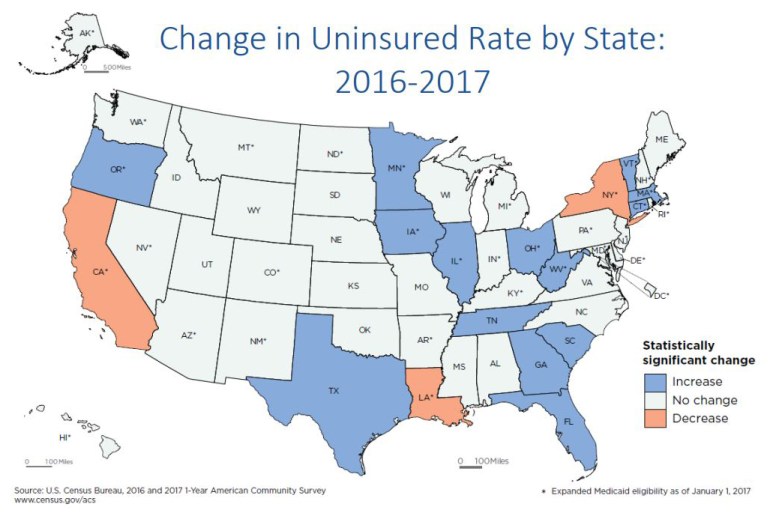The percentage of people without health insurance continued to decline in California last year, according to a closely watched report from the Census Bureau released Wednesday.
The state’s uninsured rate edged down even as Republicans in Washington, D.C. sought to roll back the Affordable Care Act. The rate of uninsurance dropped in just two other two states: New York and Louisiana.
In the Golden State, the rate of uninsured residents stood at 7.2 percent last year, compared with 7.3 percent in 2016. Since 2013, the year before the coverage-expanding provisions of the federal health law took effect, California’s uninsurance rate has dropped 10 percentage points — the largest decrease of any state, according to the Census Bureau.
“California hasn’t wavered in its efforts to expand coverage under the Affordable Care Act” despite the federal efforts to curtail it, said Laurel Lucia, director of the health care program at the University of California-Berkeley’s Center for Labor Research and Education. Because of that, “California will be able to maintain more of the progress we have made than other states,” she said.
Covered California, the state’s ACA exchange, noted in a press statement that about 59 percent of the nearly 3 million people in the state who still lack insurance are ineligible because of their immigration status.
“When you exclude those that are ineligible for coverage, California’s ‘eligible uninsured’ rate drops to roughly 3 percent,” the exchange said.
Adult immigrants without legal documents do not qualify for full benefits in Medi-Cal, the state’s version of the Medicaid health insurance program for low-income people, or for coverage through the exchange. They can purchase coverage in the private market if they have enough money.
Nationally, the percentage of Americans without health insurance was virtually the same in 2017 as in 2016 — the last year of the Obama administration — despite the Republican efforts against the ACA.
“The overall Census report shows that even in the face of incredible national turbulence, the Affordable Care Act is still working across much of the nation,” said Peter Lee, Covered California’s executive director. “The places where you are seeing failures in coverage, these are failures of states to act on behalf of their citizens.”
The uninsured rate rose in 14 states. It was not immediately clear why, since those states — Texas, Florida, Vermont, Minnesota and Oregon among them — varied dramatically by location, political leaning and whether they had expanded Medicaid under the federal health law.
An estimated 8.8 percent of the U.S. population, or about 28.5 million people, did not have health insurance coverage at any point in 2017. That was slightly higher than the 28.1 million who lacked coverage in 2016, but the rise did not affect the uninsured rate. The difference in the rate between the two years was not statistically significant, according to the Census report.
In 2013, 14.5 percent of Americans were uninsured, and by 2017 that number had dropped to 8.7 percent, according to the Census Bureau.
The Census numbers are considered the gold standard for tracking who has insurance, because the survey samples are so large.

(Courtesy of the U.S. Census Bureau)
Analysts credit the health law with helping drive down the number of uninsured. But the decline of the U.S. unemployment rate in recent years has also played a role: The proportion of people without insurance typically falls as unemployment rates decline, because more people can get health coverage at work or can better afford buying insurance on their own.
The nation’s unemployment rate has generally been falling since before 2011 and was 4.1 percent for the last quarter of 2017, the lowest level since before the Great Recession began in December 2007.
Critics of the health law said the report emphasized its deficiencies. “Today’s report is another reminder that Obamacare has priced insurance out of the reach of millions of working families,” Marie Fishpaw and Doug Badger of the Heritage Foundation said in a statement. “Despite a growing economy and very low unemployment rate, the uninsured rate remains virtually unchanged.”
But the law’s supporters instead saw the glass as half full.
“These numbers show the resilience of the Affordable Care Act,” said Judith Solomon, senior fellow at the Center on Budget and Policy Priorities. She said people still value the coverage they receive from the health law even as it’s been under attack by President Donald Trump and Republicans who want to repeal it. “It’s good news because the numbers show the strength of the ACA but bad news in that we have not seen further progress.”
Solomon expressed concern, though, about the large number of states seeing uninsured rates increase.
Uninsured rates last year ranged from a high of more than 17 percent in Texas to low of just under 3 percent in Massachusetts.
West Virginia had one of the sharpest increases in uninsured.
About 14 percent of the state’s residents were uninsured in 2013 before the ACA’s premium subsidies and Medicaid expansion began. That rate fell by nearly two-thirds by 2016. Last year, however, West Virginia’s uninsured rate crept up 0.8 percentage points to 6.1 percent, according to the Census report.

Carol Bush, who has worked as a health insurance navigator the past three years in West Virginia, expects to be uninsured by month’s end. She is losing her job amid Trump administration cuts to the Affordable Care Act navigator program. (Courtesy of Carol Bush)
Carol Bush, 58, of Elkins, W.Va., expects to lose coverage Oct. 1 because her job is ending.
It’s an unfortunate irony: Elkins has served for the past three years as a navigator helping people in her community find coverage in the health law marketplaces. Federal officials have largely scrapped that program.
The Trump administration cut funding by more than 80 percent during the past two years, saying it had no proof that navigators were helping people find coverage. Only if consumers signed up in the presence of the navigator was a session considered a success.
Bush had coverage through the University of West Virginia, which has a navigator contract that ends at the end of this month. Without employer coverage, Bush said, the cheapest insurance she could find would be about $1,100 a month. She won’t qualify for a federal subsidy to lower her premium because of her family’s income. Her husband is insured through Medicare.
Although she said she has strongly considered going without insurance because of the cost, she knows she needs it.
“In all honesty, I’ve always had some kind of health insurance, and the thought of being without it worries me,” she said. “I can’t risk getting seriously ill and incurring enormous debt at this point in my life. Peace of mind has a value too.”
Shenandoah Community Health Center, a federally funded health clinic in Martinsburg, W.Va., has started to see an increase in uninsured patients the past year, although it’s still below levels it saw before the health law’s coverage expansion began in 2014, said CEO Michael Hassing. Hassing said he believes many patients have dropped coverage, thinking the ACA’s individual mandate was repealed.
“Folks say, ‘I don’t need to have it anymore,’ and they let it go,” he said.
While the GOP failed last year to repeal the law, Congress was able to strip out one of its key features — the individual penalty for not having coverage. The vote last December eliminated that penalty starting in 2019 — meaning Americans are still required this year to have health coverage or face the consequences on their 2018 taxes.
KHN senior correspondent Anna Gorman contributed to this report.
This story was produced by Kaiser Health News, an editorially independent program of the Kaiser Family Foundation.


